“Is there a tradition in Negro art? Can a European appreciate Negro art?”: Wittgenstein on aesthetics and prejudices
Abstract
In Lectures on Aesthetics (1938), comprised of notes taken by his students and later published as part of the work Lectures and Conversations on Aesthetics, Psychology and Religious Belief, Wittgenstein makes considerations about the aesthetic experience from the clarification of a concept in particular, the appreciation, which is fundamental for the understanding of this specific domain of the language he intends to investigate - the aesthetic language. It is in this context that two questions emerge made by his student Rush Rhees, particularly referring to Negro art, that reveal opportune occasion to add, in the aesthetic discussion, the problem of prejudice that can exist in the way in which the subject appreciates the artistic production of cultures different from his own. Thus, as a result of the reflection on the concept of aesthetic appreciation, which implies the need to take account the rules of the context of the work of art in order to make a more accurate aesthetic judgment, Wittgenstein responds to Rhees by raising a series of elements that allow to reflect on the issue of prejudices that are felt including in the field of aesthetics. With this, from the Wittgensteinian thought, the possibility of sketching an answer to a theme still latent in society is identified, as it proposes to dispel prejudices and overcome the narrowness of spirit that is behind misrepresented conceptions about others cultures, with the aim of allowing, in turn, to contemplate the differences in perspectives and the wealth they represent, in favor of the exercise of respect and tolerance with regard to cultural diversity.
Downloads
DECLARATION OF ORIGINALITY AND COPYRIGHTS
I Declare that current article is original and has not been submitted for publication, in part or in whole, to any other national or international journal.
The copyrights belong exclusively to the authors. Published content is licensed under Creative Commons Attribution 4.0 (CC BY 4.0) guidelines, which allows sharing (copy and distribution of the material in any medium or format) and adaptation (remix, transform, and build upon the material) for any purpose, even commercially, under the terms of attribution.
Read this link for further information on how to use CC BY 4.0 properly.























